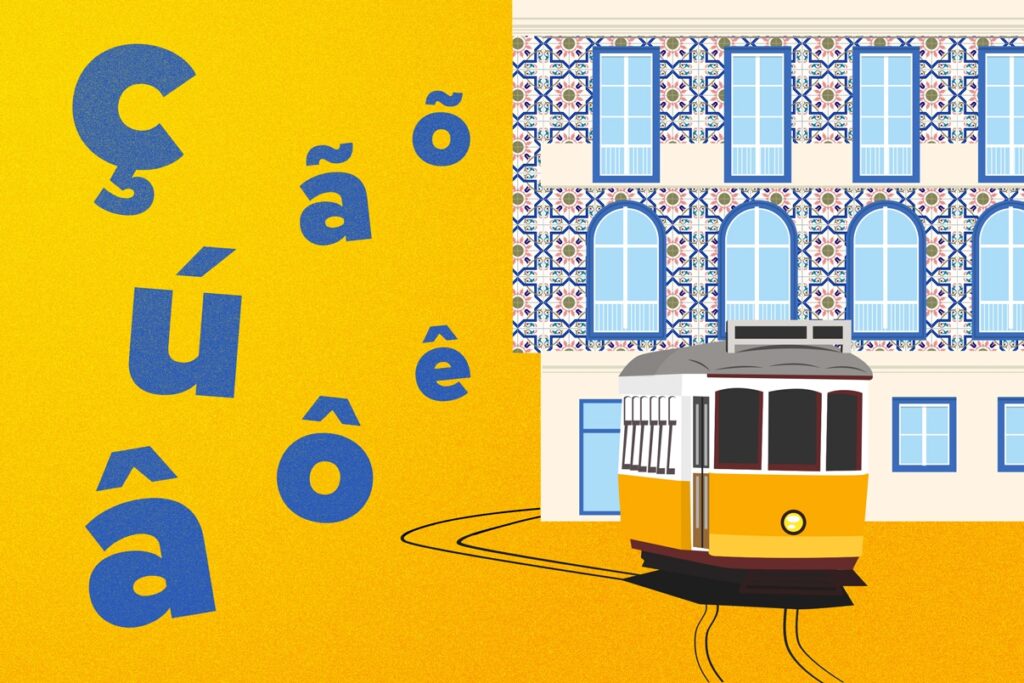Contents
Portuguese Accent Marks: Rules and Pronunciation [with Audio]

Portuguese accent marks give the language a huge diversity of sounds—the accent mark above or below a given letter can change its pronunciation just slightly… or completely.
If you want to sound more like a native, learning these different accents and how to use them is essential. We’ll go over the five types of Portuguese accent marks and how to pronounce them.
With plenty of examples and audio from a native speaker, you’ll be able to practice your pronunciation and see how accents are used in various contexts.
Download: This blog post is available as a convenient and portable PDF that you can take anywhere. Click here to get a copy. (Download)
What are Portuguese Accent Marks?
In Portuguese, there are five types of accent marks: acute accent (á, é, í, ó, ú), grave accent (à, ò), circumflex accent (â, ê, ô), tilde (ã, õ), and the cedilla (ç). As a Portuguese learner, you should pay attention to accent marks because:
- They can completely change the meaning of a word.
- They tell you where to place emphasis within a word.
- They show you how to pronounce a certain letter.
- They exist in all varieties of the Portuguese language, from Portugal and Angola to Brazil.
On that last note: Luckily, accent marks don’t vary in meaning—they have the same effect on pronunciation wherever you go.
But be careful! Just because accent marks are pronounced the same way across countries, it doesn’t mean that they’re always used in the exact same words everywhere—more on that below.
Portuguese Accent Marks and Pronunciations
In the following sections, we’ll go over each of the five different types of Portuguese accent marks, how they change words and how to use them.
The Acento Circunflexo, or Caret (^)
Letters that use it: â, ê, ô
What it does: Turns a regular letter that would be pronounced very openly into a letter that’s pronounced with a closed mouth.
How to use it:
It’s simple. All you have to do is pretend you’re drinking from a straw while pronouncing these letters!
Can you tell the difference between the letter a in the English word “father” and the absolutely different type of a you’d find in the word “alphabet”?
This difference also exists in Portuguese, too—we just sometimes use an accent mark to change a into the kind you find in “alphabet.”
The same is true for the letters e and o.
For instance, in a word like ferro (iron), the letter e will sound like in the English word “better.” That would be the typical e sound in the Portuguese language.
However, words that use a caret will transform into something similar to the English sound in the word “sin” or “win.”
Similarly, while the letter o would regularly be heard in Portuguese either as a very open letter (like in the English word “odd”) or as pretty much the same as the letter u (like in the English word “troops”), the caret changes everything once again!
Can you think of the o sound in the English word “flow”? That’s the effect of this little “hat” in the Portuguese vowel!
Examples:
âmbito (scope)
âmbar (amber)
pêlo (hair)
Inês (female name)
pôr (to put)
Remember: Not every word that includes this sound will necessarily have an accent mark to signal it.
For example, the words amigo (friend), dentro (inside) and porco (pig) all have vowels that are pronounced exactly as if they had a caret on them, but they don’t. You’ll learn as you go… promise!
The Agudo e Grave, or Acute and Grave Marks (´, `)
Letters that use them: á, à, é, í, ó, ú
What it does: Forces any letter to be very, very open, and places the stress on that letter.
How to use them:
Open your mouth and say “Aaaah”!
Here’s a guide to the equivalent sounds in English:
- á, à — aaahhhh (like in “father”)
- é — eh (like in “seven”)
- í — ee (like in “peak”)
- ó — oh (like in “odd”)
- ú — oo (like in “roof”)
You might be wondering what the difference is between á and à. In terms of pronunciation, they’re exactly the same.
Actually, the difference is only found in writing—you’ll only find à when the letter stands alone or with an s in front of it with the meaning of “to” or “on.” I know, it’s so specific!
Here are some examples of this:
Eu só como sopa às sexta-feiras. (I only eat soup on Fridays.)
Estou à espera! (I’m waiting!)
Vou à Alemanha. (I will go to Germany.)
Fui às cidades mais bonitas da Europa. (I went to the most beautiful cities in Europe.)
When using this accent mark in any other situation, always use the one pointing to the right side, like in the examples below.
Examples:
há (there is, there are)
máquina (machine)
má (evil or mean female)
épico (epic)
íntimo (intimate)
óbvio (obvious)
útil (useful)
à (to, on)
Remember: Just like with the caret, this sound isn’t always accompanied by an accent mark.
The following words, for example, all have vowels that are pronounced exactly as if they have an acute accent mark on them, but they don’t:
pai (father)
mala (bag)
ferro (iron)
colo (lap)
Step by step, you’ll start getting used to these specific words.
Also: Remember the caret? Keep in mind that where European Portuguese (in Portugal) uses ó, Brazilian Portuguese will often use ô instead, with the necessary pronunciation changes.
Examples of this are:
arquitetónico (PT) → arquitetônico (BR)
anatómico (PT) → anatômico (BR)
This means that European Portuguese actually has some open vowel sounds that transform into very closed sounds in Brazilian Portuguese, and vice-versa.
The Til, or Tilde (~)
Letters that use it: ã, õ
What it does: Changes a regular letter into one with a nasal sound.
How to use it:
Think of the English word “part.” Now think of the English word “train.” Can you hear how the letter becomes slightly more nasal in the latter—that is, you use your nose to create the sound more than usual?
Similarly, the regular o in Portuguese would sound either like in the English word “boy” or “roof” (depending on the position of the letter inside a word… but that’s a story for another post!), but the letter õ would be pronounced as in the word “ointment”—again, a little bit more nasal.
Examples:
mãe (mother)
cão (dog)
canção (song)
intenção (intention)
relação (relationship)
põe (he/she/it puts, or imperative “put”)
orações (prayers)
corações (hearts)
One thing you’ll soon notice about the Portuguese language is that whenever a word ends in –ão in the singular, it’s likely to use the sounds –ãos and –ões in its plural version.
Additionally, if the word ends in –ãe in the singular, it’s likely to end with –ães in the plural version.
Here are some times when this happens:
coração → corações (heart → hearts)
canção → canções (song → songs)
By the way, did you know that the letter e can also have its own nasal version, even though it’s not signaled with an accent mark?
Check the pronunciation of these words: sem (without), cem (one hundred) and tem (he/she/it has). See how that sounds extremely similar to ãe? That’s because it’s the exact same sound, only written a different way!
You’ll find this a lot in the Portuguese language: several sounds are similar, just written differently.
The Cedilha, or Hook (¸)
Letter that uses it: ç
What it does: Turns a regular hard c into an s sound.
How to use it:
In Portuguese, we have at least four different ways of writing the regular, normal sound s: with an s, with a c (only when followed by an e or an i), with a double s (ss) and with a ç.
This means that these words all have the same s sound, despite being written differently: cedo (early), saco (bag), sede (thirst), massa (pasta), sedar (to sedate), cela (prison cell), segundo (second), segredo (secret), seca (drought), cimento (cement) and Cinderela (Cinderella).
Add the letter ç to this repertoire! Whenever you see the letter ç, you must pronounce it as a strong s.
Examples:
maçã (apple)
maçaneta (door handle)
canção (song)
praça (city square)
descrição (description)
esperança (hope)
intenção (intention)
ambição (ambition)
relação (relationship)
How to Type Portuguese Accent Marks
On a Mac Device
If you’re in an app that supports accent marks, follow these steps:
- Press and hold a letter key on the keyboard (like a) to display the accent menu.
- The menu will only be shown if the key has any possible accent marks.
- Select a character in the menu (for example, á) by clicking on it with your mouse, pressing the corresponding number key shown in the menu, or using the arrow keys to move to the character and then pressing the Space bar.
If you’re in an app that doesn’t support accent marks, try the dead keys option.
On a PC/Windows Device
To type accent marks in an application like Word or Outlook, follow the instructions below. Keys separated by a plus sign must be pressed at the same time while keys after a comma should be pressed right after releasing the previous keys.
- For the caret mark (â, ê, ô): CTRL + SHIFT + caret key (^), the letter key you want to add the accent to
- For the acute mark (á, é, í, ó, ú): CTRL key + apostrophe key (‘), the desired letter key
- For the grave mark (à): CTRL + accent grave key (`), the a key
- For the tilde (ã, õ): CTRL + SHIFT + tilde key (~), the desired letter key
- For the hook mark (ç): CTRL+ comma key (,), the c key
If you need an accent on an uppercase letter, turn on Caps Lock before using the shortcut keys above.
Portuguese accent marks can be tricky, but as you get exposed to more written and spoken Portuguese, you’ll naturally get more familiar with the accent marks and the sounds they produce. With the FluentU program, you’ll get to listen to and see the accent marks in Portuguese media clips, thanks to the interactive subtitles.
FluentU takes authentic videos—like music videos, movie trailers, news and inspiring talks—and turns them into personalized language learning lessons.
You can try FluentU for free for 2 weeks. Click here to check out the website or download the iOS app or Android app.
So gather a few learning resources and let those little accent marks lead the way to expert pronunciation!
Download: This blog post is available as a convenient and portable PDF that you can take anywhere. Click here to get a copy. (Download)
And One More Thing...
If you're like me and enjoy learning Portuguese through movies and other media, you should check out FluentU. With FluentU, you can turn any subtitled content on YouTube or Netflix into an engaging language lesson.
I also love that FluentU has a huge library of videos picked specifically for Portuguese learners. No more searching for good content—it's all in one place!

One of my favorite features is the interactive captions. You can tap on any word to see an image, definition, and examples, which makes it so much easier to understand and remember.
And if you're worried about forgetting new words, FluentU has you covered. You'll complete fun exercises to reinforce vocabulary and be reminded when it’s time to review, so you actually retain what you’ve learned.
You can use FluentU on your computer or tablet, or download the app from the App Store or Google Play. Click here to take advantage of our current sale! (Expires at the end of this month.)










